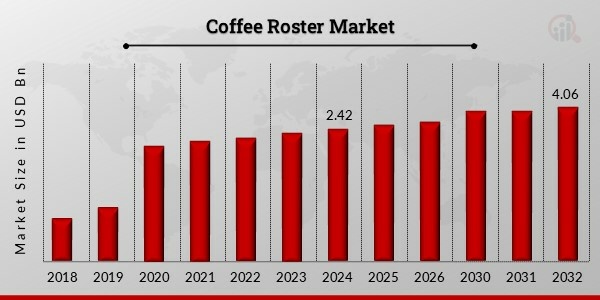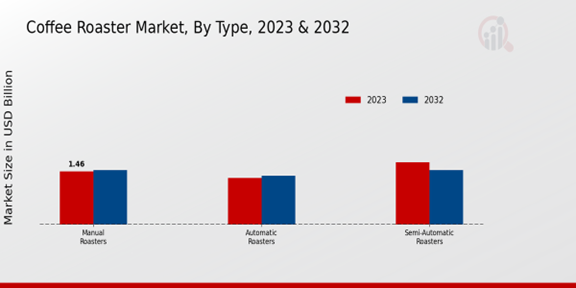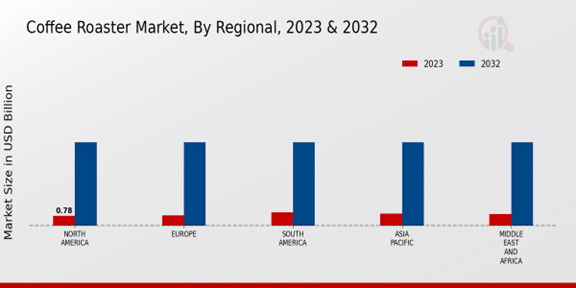Global Coffee Roaster Market Overview
Coffee Roaster Industry is expected to grow from 2.42 (USD Billion) in 2024 to 4.06 (USD Billion) by 2032. The Coffee Roaster Market CAGR (growth rate) is expected to be around 6.68% during the forecast period (2024 - 2032).

Source Primary Research, Secondary Research, MRFR Database and Analyst Review
Key Coffee Roaster Market Trends Highlighted
Key market drivers for coffee roasters include the rising popularity of specialty coffee, increased demand for convenience, and growing awareness of the health benefits of coffee.
Opportunities to be explored include the development of new roasting technologies, expansion into emerging markets, and the creation of value-added products.
Recent trends in the coffee roaster market include the shift towards small-batch roasting, the use of sustainable practices, and the incorporation of smart technology. As the market continues to evolve, it is important for coffee roasters to stay abreast of the latest trends and developments in order to meet the changing needs of consumers.
Coffee Roaster Market Drivers
Increasing Demand for Specialty Coffee
Specialty coffee has attained growing popularity in recent times. The increasing acceptance of specialty coffee has augmented the demand for freshly roasted coffee beans. Specialty coffee is distinctive in terms of both its flavor and fragrance, as the roasting of coffee beans is carried out nearly to perfection, together with precise determination of the blend of coffee to be roasted. As a consequence, the demand for specialty coffee and, correspondingly, for coffee roasters protracting further processing of coffee beans to ensure the best quality is projected to grow and sustain in the future.
Expansion of the Coffee Shop Industry
Another major driver of growth in the Coffee Roaster Market Industry is the expansion of the coffee shop industry. Nowadays, coffee shops are one of the most popular places to be with friends, work or just relax. People go to coffee shops on a regular basis, so many coffee suppliers need a constant supply of fresh coffee beans. Moreover, the growth of the coffee shop industry is projected to continue in the next few years, as consumption of coffee has been increasing and coffee house chains seek new markets to enter.
Technological Advancements in Coffee Roasting
Moreover, in the Coffee Roaster Market Industry, the facilitation of the development of modern machines is evidently seen as there are new roasting machines that are launched on a regular basis that offer more accuracy and provide the manufacturers with greater control of the process. As a result, the production of coffee beans becomes more constant. In addition, modern packaging technologies permit coffee to be roasted and then consumed for a longer period of time.
Coffee Roaster Market Segment Insights
Coffee Roaster Market Type Insights
The coffee roaster market is classified into three types – manual roasters, automatic roasters, and semi-automatic roasters. Manual roasters are the simplest type of roaster that requires the user to control the roasting process manually. Automatic roasters are more advanced and can be fitted with a program to roast coffee beans as per the desired profile. Semi-automatic roasters are a combination of both. Some of its features are automated, and for the rest, the user has to provide input. In 2023, the manual roasters segment is expected to have the largest coffee roaster market share.
Its revenue is expected to be USD 1.2 billion. However, the best prospect is that of the automatic roasters segment. It is likely to have the highest coffee roaster market CAGR of 4.8%. As a result, it will be worth USD 1.8 billion in 2032. The semi-automatic roasters segment is expected to earn a revenue of USD 1.5 billion at a CAGR of 4.2%. There are several reasons why the automatic roasters segment is likely to be the most significant. They are There is a rising demand for automatic roasters as they have the capability to roast coffee consistently and better.
Advantages Automatic roasters are better than manual roasters for the following reasons They can be programmed to ensure that the coffee beans are roasted as per the required profile at the right time. They are of superior quality and technology and, hence, can offer better products. Automatic roasters are more efficient, hence forcing manual roasters to reduce inefficiency, such as lack of productivity resulting from always being too busy or absent. The growth of the semi-automatic roasters segment is expected to be 4.2% of CAGR as there is a growing demand for flexibility and customization.
Semi-automatic roasters are, like automatic roasters, better than manual roasters in terms of technology. When using them, though, the only disadvantage is the loss of control of the manual roasting process. Their most significant benefit is the possibility for the user to try different combinations and hand-make the roast profile so that they can produce their own special coffee blend. The coffee roaster market is expected to grow at a CAGR of 4.5% and earn a revenue of USD 6.5 billion by 2032. This is because both manual and automatic roasters are becoming more popular with the growth of the coffee market.

Source Primary Research, Secondary Research, MRFR Database and Analyst Review
Coffee Roaster Market Capacity Insights
The Coffee Roaster Market segmentation by capacity encompasses Small-Capacity Roasters, Medium-Capacity Roasters, and High-Capacity Roasters. In 2023, the Small-Capacity Roasters segment held a significant market share due to their affordability and suitability for small-scale coffee businesses. Medium-capacity roasters are projected to witness substantial growth over the forecast period, owing to their ability to cater to the needs of medium-sized coffee shops and roasters. High-capacity roasters are anticipated to account for a notable share of the Coffee Roaster Market revenue, primarily driven by the increasing demand for large-scale coffee production from commercial coffee chains and multinational corporations.
Coffee Roaster Market Fuel Type Insights
The Coffee Roaster Market revenue is projected to increase significantly by 2024 and beyond, driven by the rising demand for specialty coffee and the growing popularity of home roasting. The market segmentation based on fuel type offers valuable insights into the industry dynamics. Electric roasters and gas roasters are the two primary fuel types used in the coffee roasting process, each with its unique advantages and market share. Electric roasters are gaining popularity due to their ease of use, precise temperature control, and energy efficiency.
They are particularly suitable for small-scale roasting operations and home enthusiasts. The Coffee Roaster Market data indicates that electric roasters are expected to account for a significant share of the market revenue in the coming years. Gas roasters, on the other hand, are preferred by larger roasting facilities due to their higher roasting capacity and ability to produce a wider range of roast profiles. They offer greater control over the roasting process, allowing for more complex and nuanced flavors. The Coffee Roaster Market statistics show that gas roasters currently hold a larger market share compared to electric roasters, but the gap is expected to narrow as electric roasters become more advanced and cost-effective.
Understanding the fuel type segmentation in the Coffee Roaster Market industry is crucial for businesses operating in this space. It helps manufacturers and suppliers tailor their products and services to meet the specific needs of different customer segments. Moreover, tracking market growth and emerging trends within each fuel type segment enables stakeholders to make informed decisions and stay competitive in the market.
Coffee Roaster Market End Use Insights
The Coffee Roaster Market revenue from the Commercial end-use is estimated to be valued at USD 2.9 billion in 2023 and is projected to reach USD 4.2 billion by 2032, growing at a CAGR of 4.6%. The growth of the commercial segment can be attributed to the increasing popularity of specialty coffee shops, cafes, and restaurants, which require high-quality roasted coffee beans. The Home end-use segment is expected to grow at a steady pace, with a projected CAGR of 3.8% over the forecast period. The growth of the home segment can be attributed to the increasing demand for home brewing equipment and the growing popularity of at-home coffee consumption.
Coffee Roaster Market Roasting Degree Insights
The roasting degree is a key factor that determines the flavor profile of coffee. Different roasting levels can bring out different flavors and aromas in the same coffee bean. Light Roast coffee beans are roasted for a shorter period of time, resulting in a lighter color and a brighter, more acidic flavor. Medium-roast coffee beans are roasted for a longer period of time, resulting in a darker color and a more balanced flavor with a hint of sweetness. Dark Roast coffee beans are roasted for the longest period of time, resulting in a very dark color and a strong, bold flavor with a smoky aroma.
The Coffee Roaster Market revenue is expected to grow significantly in the coming years, driven by the increasing popularity of specialty coffee and the growing demand for premium coffee products. The market is segmented based on roasting degree, with Light Roast, Medium Roast, and Dark Roast being the three main segments. Among these segments, Light Roasted coffee is expected to witness the highest growth rate in the coming years, owing to the increasing preference for lighter roasts among younger consumers. Medium Roast coffee is also expected to witness a steady growth rate, as it appeals to a wider range of consumers.
Dark Roast coffee is expected to witness a moderate growth rate as a more niche group of consumers prefers it.
Coffee Roaster Market Regional Insights
The regional segmentation of the Coffee Roaster Market provides insights into the market's geographic distribution and growth patterns. North America held the largest revenue share in 2023, accounting for around 35% of the market. The region's strong coffee culture, high disposable income, and presence of major coffee roasters contribute to its dominance. Europe follows closely with a significant share, driven by its sophisticated coffee consumption habits and specialty coffee trends. The Asia-Pacific (APAC) region is projected to witness the highest growth rate during the forecast period, owing to the rising consumption of coffee in countries like China and India.
South America, the Middle East, and Africa (MEA) also have the potential for growth, with increasing urbanization and growing consumer demand for premium coffee. The Coffee Roaster Market revenue is expected to reach 4.85 Billion USD in 2024, exhibiting a steady growth trajectory in the coming years.

Source Primary Research, Secondary Research, MRFR Database and Analyst Review
Coffee Roaster Market Key Players And Competitive Insights
The report covers a detailed competitive outlook, including the market share and company profiles of the key participants operating in the market. Key players profiled in the report include Keurig Dr Pepper, JDE Peet's, Nestle, Luigi Lavazza S.p.A., Starbucks Corporation, Strauss Group, Tchibo GmbH, illycaff S.p.A., among others. Company profile includes assigning such as company summary, financial summary, business strategy and planning, SWOT analysis and current developments.
Leading Coffee Roaster Market companies like Keurig Dr Pepper, JDE Peet's, Nestle, Luigi Lavazza S.p.A., Starbucks Corporation, Strauss Group, Tchibo GmbH, illycaff S.p.A., and others are constantly focusing on innovation and the launch of their new products to cater to the changing needs of their consumers will upsurge the growth of the Coffee Roaster Market. In addition to that, the Coffee Roaster Market industry competitive landscape section of the report provides a clear insight into the market share analysis of the key industry players. Key development, expansion, strategies, mergers and acquisitions, JVs, and all other expansions are also analyzed in the competitive landscape to raise the Coffee Roaster Market-CAGR.
The product segment is split into electric roasters and gas roasters. Based on the product, the coffee roaster market is proportioned to gas and electric roasters. The report provides an analysis of each product segment gas roasters, electric roasters, and more. A brief overview of both segments is provided in the report. Keurig Dr Pepper is a Coffee Roaster Market company. The Company is based in the United States. The Company operates in the beverage and coffee business. The coffee systems segments provide single-serve coffee makers, coffee pods, and other related products. The beverages segment provides ready-to-drink coffee, tea, and other non-carbonated beverages. The Company is North America's Beverage Company. The Company has a very strong brand portfolio and has the advantage of the highest level of innovation in the industry. Keurig Dr Pepper has an unparalleled distribution system across the United States. JDE Peet's is the Coffee Roaster Market Company. The Company is Netherlands-based. The Company operates its business in coffee and tea. The coffee segment has products including roasted and ground coffee, instant coffee, and other coffee products. The tea segment includes black tea, green tea, and other tea. The distributors of JDE Peet’s are scattered across the globe, making the Company the No 1 coffee roaster in the world.
Key Companies in the Coffee Roaster Market Include
Coffee Roaster Market Industry Developments
The coffee roaster market is projected to reach USD 6.5 billion by 2032, exhibiting a CAGR of 4.22% during the forecast period. Increasing demand for specialty coffee, growing popularity of home brewing, and rising disposable income in emerging economies are the key factors driving market growth. Technological advancements, such as the introduction of smart roasters and automated roasting systems, are further contributing to market expansion. The market is witnessing a surge in demand for sustainable and ethically sourced coffee, leading to the emergence of eco-friendly roasting practices and fair trade initiatives. Key industry players are focusing on product innovation and strategic partnerships to cater to the evolving needs of consumers.
Coffee Roaster Market Segmentation Insights
|
Report Attribute/Metric
|
Details
|
|
Market Size 2023
|
2.42 (USD Billion)
|
|
Market Size 2032
|
4.06(USD Billion)
|
|
Compound Annual Growth Rate (CAGR)
|
6.68% (2024 - 2032)
|
|
Report Coverage
|
Revenue Forecast, Competitive Landscape, Growth Factors, and Trends
|
|
Base Year
|
2023
|
|
Market Forecast Period
|
2024 - 2032
|
|
Historical Data
|
2019 - 2023
|
|
Market Forecast Units
|
USD Billion
|
|
Key Companies Profiled
|
Modbar, Loring Smart Roasters, Diedrich Roasters, Buhler AG, Toper Industries, Sivetz Coffee, W.F Roasting Company, Probat Burns, Petroncini, Scolari Engineering, Sasa S.p.A., Giesen Coffee Roaster, Thermoplan AG, Royal Coffee, Coffee Bean International
|
|
Segments Covered
|
Type, Capacity, Fuel Type, End Use, Roasting Degree, Regional
|
|
Key Market Opportunities
|
Rising demand for specialty coffee Growing popularity of home roasting Increasing focus on sustainability Technological advancements in roasting equipment E-commerce Expansion
|
|
Key Market Dynamics
|
Rising popularity of specialty coffee Increasing demand for artisanal roasts Growing awareness of coffee's health benefits Technological advancements in roasting equipment Expansion of online coffee retailers
|
|
Countries Covered
|
North America, Europe, APAC, South America, MEA
|
Frequently Asked Questions (FAQ) :
The Coffee Roaster Market is expected to reach a valuation of 2.42 billion USD in 2024 and is projected to grow at a CAGR of 6.68%, reaching a valuation of 4.06 billion USD by 2032.
The Asia-Pacific region is anticipated to be the fastest-growing market for coffee roasters due to increasing urbanization, rising disposable income, and changing lifestyles. North America and Europe are also significant markets for coffee roasters, with established coffee cultures and a growing demand for premium coffee.
Coffee roasters are primarily used in commercial settings such as coffee shops, restaurants, and cafes to roast coffee beans. They are also gaining popularity in-home use as consumers seek to create their own custom coffee blends and enjoy freshly roasted coffee.
Some of the key competitors in the Coffee Roaster Market include Diedrich Roasters, Probat, Giesen, Loring, and San Franciscan Roaster Co. These companies offer a range of coffee roasters designed to meet the needs of different customers, from small-batch roasters for home use to large-scale commercial roasters.
The growth of the Coffee Roaster Market is primarily attributed to the increasing popularity of specialty coffee and the growing demand for freshly roasted coffee. The rise of e-commerce and online coffee subscriptions has also contributed to the market's growth by making it easier for consumers to access a wider variety of coffee beans and roasts.
One of the challenges faced by the Coffee Roaster Market is the fluctuating prices of coffee beans, which can impact the profitability of coffee roasters. Additionally, the market is becoming increasingly competitive, with new entrants offering innovative products and services.
Opportunities for growth in the Coffee Roaster Market include the expansion into emerging markets, the development of new coffee roasting technologies, and the growing demand for sustainable coffee practices.
Some of the latest trends in the Coffee Roaster Market include the increasing popularity of light and medium roasts, the growing demand for single-origin coffees, and the rise of home coffee roasting.
The Coffee Roaster Market is expected to continue growing in the coming years, driven by the increasing popularity of specialty coffee and the growing demand for freshly roasted coffee. The market is also expected to benefit from the expansion into emerging markets and the development of new coffee-roasting technologies.
When choosing a coffee roaster, it is important to consider factors such as the type of coffee beans you want to roast, the capacity of the roaster, the features of the roaster, and the price of the roaster.

















